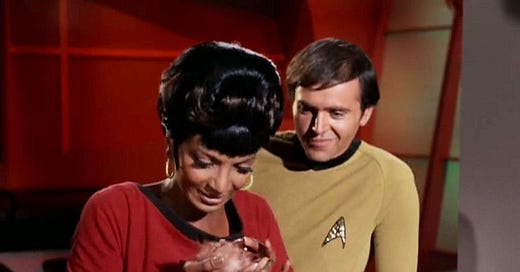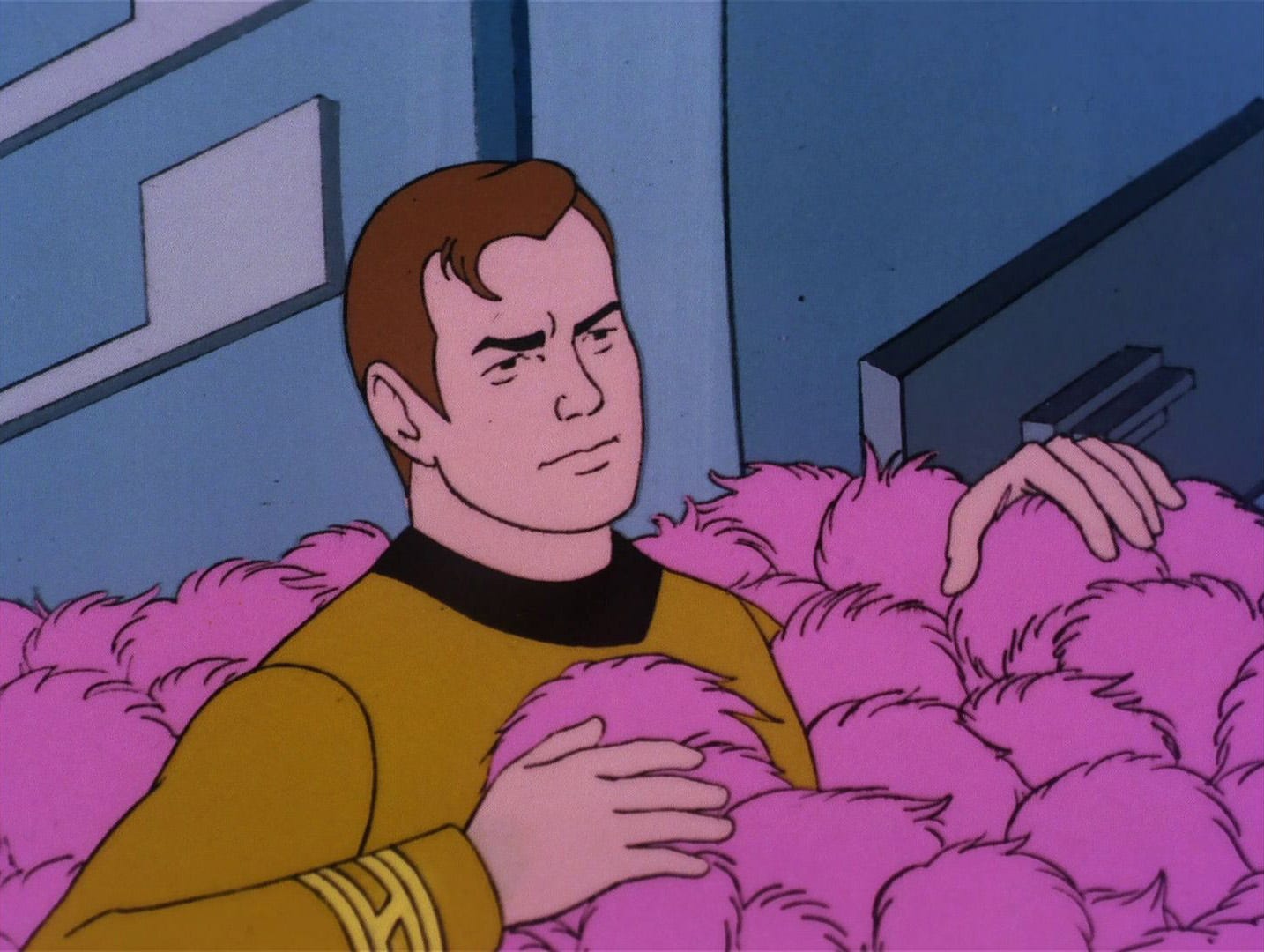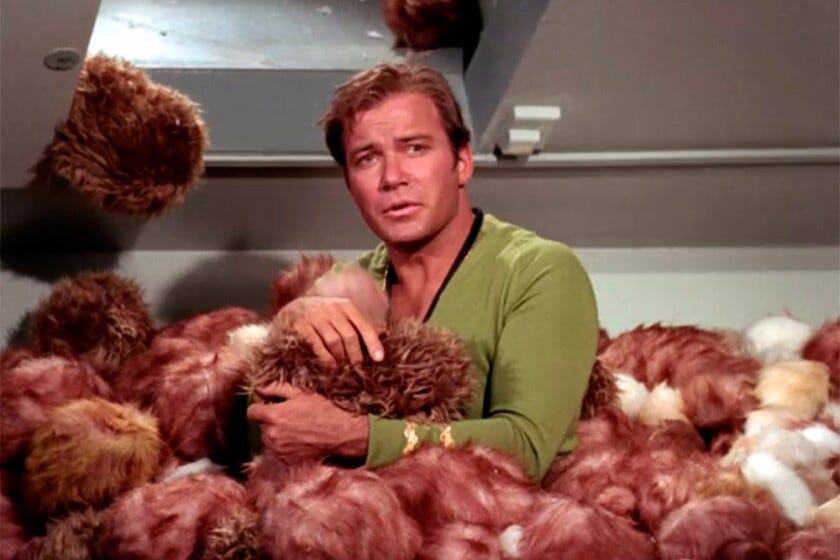"The Trouble with Tribbles" - Season 2, Episode 15
Star Trek's comedy slot takes over the galaxy.
There is more information on “The Trouble With Tribbles” than almost any other episode of Star Trek, which makes writing something original on it rather difficult. There is some irony in that - the episode is a clear piece of plagiarism - but there is little mystery. David Gerrold, the episode’s writer, will talk to seemingly anyone about it, and his near-activist presence for his own script likely accounts for the outsized place of this fun, light bit of comedy in the Star Trek fandom as well as the fact that it is the only episode to receive a disc all to itself on the Season 2 Blu-Ray collection. “The Trouble with Tribbles” is an amusing and good time, more tonally consistent than Trek’s other swings at straight comedy. But it is slight, small, and straightforward. Is it possible to say why this bit of farce is so famous?
Perhaps part of it is that the episode’s origin story amounts to a wish-fulfilment fantasy many fans have seized on, as Gerrold was a fan of Star Trek before he was a writer for it. He worked adjacent to the entertainment industry - when it was accepted, he was a 22 year old typist at CBS - but spent his free time sending spec scripts to television producers. What became “The Trouble with Tribbles” was his fifth submission, initially titled “The Fuzzies,” and was developed after Trek producer Gene L. Coon saw some promise in Gerrold’s earlier work.
David Gerrold never wrote for a live-action Star Trek show again. However, he did continue pitching. One pitch was a sequel episode for the third season, in the vein of “I, Mudd,” that featured the return of the Tribbles and Cyrano Jones. While it was not produced then, the script was later produced as an episode of Star Trek: The Animated Series. Gerrold wrote one other episode of The Animated Series, while the Tribbles reappeared in the Deep Space Nine episode “Trials and Tribble-ations.”
“The Fuzzies” retained the basic outline of “The Trouble with Tribbles” but presented an issue: it was extremely similar to the Robert Heinlen novel The Rolling Stones, which features a species of Martian “flat cat” - described as featureless purring balls of fur - that reproduce quickly and overwhelm a family’s spaceship. Gerrold later admitted to having read the book at some point before writing the script, although denies it was on his mind. Undercutting this idea is the fact that, while the accounts vary in particulars, Coon called Heinlein and requested that the legendary author grant a rights waiver. Heinlein agreed, although later came to regret it:
If that matter had simply been dropped after that one episode was filmed, I would have chalked it up wryly to experience. But the 'nice kid' did not drop it; 'tribbles' (i.e. my 'flat cats') have been exploited endlessly… Well that’s one that did 'larn me.' Today if J. Christ phoned me on some matter of business, I would simply tell him: 'See my agent.'1
Heinlein himself has also acknowledged, however, that the fast-producing fur monster issue in his book owed something to Pigs is Pigs, a 1905 short story by American author Ellis Parker Butler, where the same issue arises with guinea pigs.
With legal issues out of the way, “The Trouble with Tribbles” could go ahead. As produced, it is lovely, deft, and rather funny.
Cyrano Jones, left, sizes up a mark. Jones was played by Stanley Adams, a supporting comedic actor 60s classics like Breakfast at Tiffany’s (1961) and Lilies of the Field (1963). Adams was also an accomplished television writer, and even co-wrote Star Trek’s season 3 episode “The Mark of Gideon.”
The Enterprise is called to Deep Space Station K7 under false pretenses, as an emergency distress call leads them to believe the station - a useful supply post close to the contested Sherman’s Planet - is under attack by Klingons. Not so! Instead, K7 Administrator Nilz Baris has called the Enterprise there to work security, guarding a particularly hardy grain deposit set for shipment to Sherman’s Planet. As ownership of the planet will ultimately determined by whether the Klingons or Federation develop it more “efficiently,” the food is of vital strategic import. Kirk, still, is rather annoyed.
A lot of the episode’s best bits come from Kirk, as he spends most of it annoyed, pissed, or otherwise dealing with issues he clearly does not care all that much about. Baris gets on his nerves endlessly; a typical exchange follows:
BARIS: Captain Kirk, I consider your security measures a disgrace. In my opinion, you have taken this important project far too lightly.
KIRK: On the contrary, sir. I think of this project as very important. It is you I take lightly.
His second annoyance arises later though, with the Enterprise ordered to follow Baris’s orders, the crew rotate in and out of K7 on shore leave, which is also being visited by a Klingon crew led by the seemingly good humored Captain Koloth. Onboard L7 is a Harry Mudd style goods hawker named Cyrano Jones, who sells Uhura a small purring ball of fur called a Tribble. The crew is enamored of the little guy - McCoy later, hilariously, states that all Tribbles are actually “bisexual” but means “hermaphroditical” - and feed him well. One Tribble becomes two. four. eight. sixteen. It is exponential.
The ship is soon swarmed by the things, clinging to walls and hiding in seats, causing such a problem that Baris believes Cyrano Jones to be a Klingon agent. He gains evidence for the theory when it is revealed that the Tribbles have eaten through the entire grain storage supply. Kirk’s opening of the silo - full of literally hundreds of Tribbles - leads to one of the most iconic images in Star Trek’s history.
Kirk, buried in Tribbles, notices that many are actually Tribble corpses. Many have died, cause unknown. McCoy’s examinations confirm that the grain was poisoned; Klingons are the natural suspects - the crew do not believe Cyrano Jones smart or motivated enough - and Tribbles react fearfully when brought near them. This reaction breaks the cover of the true Klingon agent: Baris’s assistant Darvin. He is hauled to the brig, Cyrano Jones, having ignorantly caused the whole mess, is ordered to round up all excess Tribbles - apparently an 18 year long task! - and the Enterprise solves infestation by transporting them all onto the Klingons’ nearby ship. As Scotty immortally says, the creatures should be “no tribble at all.”
Writing about comedy is often difficult because it can easily turn into a listing exercise, as the author states what they found funny, and it can be hard to describe why we find certain things funny. There are writers equipped for this, practiced, with a firm grasp of their sense of humor. Well, dear reader, I am not one of those writers; I find - to pick randomly - Freddie Got Fingered, Bottoms, Blazing Saddles, and Bringing Up Baby all hilarious.2 This episode is straightforwardly comedic, apparently an obligation for a season’s 15th episode given “Shore Leave.” It has a plot made of escalating mishaps, an absurd extended fight scene recalling the end of The Quiet Man, and stakes that genuinely do not matter: the fate of Sherman’s Planet is never addressed. But it does have moments I found very funny.
Shatner is a gem throughout, frankly. Upon being informed about how special the grain is for the fourth time - all played straight - he shouts “Does every one know about this wheat but me?” in total exasperation, and it got me good. His annoyance at the situation starts mild and grows until he flat out tells Baris he will throw him in jail if he doesn’t shut out. He acquits himself ably and seems less precious with his performance and Kirk than popular accounts often imply; a man concerned only with his image does not allow himself to be covered in Tribbles, hair frazzled and askew. Beyond the Captain, the episode gets character comedy out of Spock’s against-type enjoyment of the creatures, and McCoy’s dip into veterinarian medicine. When the good doctor announces that they can stop the Tribbles from reproducing by not feeding them, it’s a “duh” moment that gets a laugh solely because of the eagerness with which DeForest Kelley delivers the obvious.
“Tribbles” also benefits from Joseph Pevney’s typically strong direction and visuals, here realizing Deep Space Station R7 as a procession of bold, expressively lit interiors. This is not utility lighting; Baris’s office is washed in purples and greens, other rooms in deep red. The only room seemingly lit for utility is the station’s cantina, probably to ensure that the extended fights scene between drinking Klingons and the Enterprise crew is legible.
This has all been a long way of saying that the episode is good, but difficult to write about. Spock drops a few lines about pets that suggest some interest in exploring why people think fuzzy little animals are cute, but that is never truly developed. No, “The Trouble with Tribbles” is concerned only with fun, and fun it is. I find its place in the wider imagination a bit baffling - it is funny, but not that funny - although I do, finally, have an idea about why. People do think fuzzy little animals are cute. It is a pretty great joke, then, to make them such a big problem.
Stray Thoughts
Producing the Tribbles was the work of Jacqueline Cumeré, a production assistant, who was paid $350 for 500 total Tribbles. Every available Tribble model was used in the scene where Kirk is buried among them.
Koloth, the Klingon Captain, was played by William Campbell, who you may remember as Trelane, the Napoleon obsessed god-child, from “The Squire of Gothos.” He is noticeably more charming and believable than other Klingon portrayals so far; he has a kind of arch way of speaking to Kirk that comes off as an oddly professional way of speaking with an adversary.
Photo Credits
Patterson, William H. (2016). Robert A. Heinlein, Vol 2: In Dialogue with His Century Volume 2: The Man Who Learned Better, p. 290-91.
At least three of these are complete absurdist farces. Maybe my taste skews Big rather than “Witty.” Given that the funniest movie I have seen this year is Hundreds of Beavers, a kind of live-action cartoon realized through cut-out animation and the aesthetics of video games and the plotting of Buster Keaton, I may be onto something.






![Star Trek] What is society actually like on Earth in the 24th century? Is it truly a utopia that the 21st century can aspire to? : r/AskScienceFiction Star Trek] What is society actually like on Earth in the 24th century? Is it truly a utopia that the 21st century can aspire to? : r/AskScienceFiction](https://substackcdn.com/image/fetch/w_1456,c_limit,f_auto,q_auto:good,fl_progressive:steep/https%3A%2F%2Fsubstack-post-media.s3.amazonaws.com%2Fpublic%2Fimages%2F0fabc5c9-011e-4f87-ae50-3496f38eef71_1446x978.jpeg)
